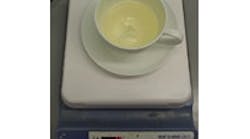TEST IN A TEACUP
Figure 1. Catalyst can promote chemical reduction at ambient conditions, even in a teacup. Source: University of New South Wales.
Tests of the catalyst for reducing imines showed that it worked at ambient conditions and provided the corresponding amine at more than 90% yield in most cases. More details appear in a recent article in
Angewandte Chemie International Edition.The team even tested the system in a teacup
(Figure 1). "I thought it would be a bit of fun. And it makes a serious point — our catalyst system is very easy to use," says Colbran."In principle, we believe the general catalyst design can be adapted to hydrogenation of any unsaturated substrate, through careful choice of the catalyst components — the metal centered and abutted organic donor of hydride ion," he explains. "We are currently making and testing a range of catalysts with the same overall catalyst design…""Electricity or light could be used to drive the reduction reactions using our catalyst," he adds. "This is unlikely to be of importance in fine chemical processing, but has immense potential if we can realize reduction of carbon dioxide to methanol, which is a current goal… We already have promising results for electrochemically driven reduction."Right now, the researchers are striving to replace rhodium with cheaper iron or cobalt, extend the catalysis to asymmetric reduction, and optimize catalyst life and product yields, says Colbran"The proof-of-principle catalyst that we reported suffers from poor stability and, so, poor turnover numbers," he admits. "The catalyst design needs to be optimized for stability before testing on a pilot-plant scale is considered."We'd like to emphasize that our approach closely mimics how biology has optimized chemical reduction. We are convinced our approach offers great potential, but it needs development. We would welcome partnerships to advance our technology."
